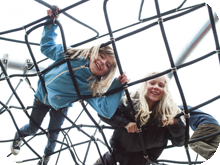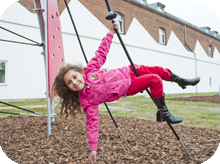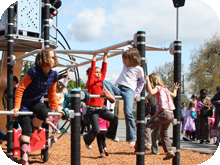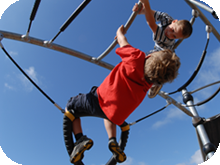
This mailer has been provided as an avenue to disperse information pertinent to architects and the landscape architecture profession in hopes of fostering greater understanding and collaboration. Topics address issues that affect the built environment within which we live.
Introduction
Regular access to informal play on outdoor playgrounds provides kids with experiences they desperately need for their development and well-being: aerobic activity, social interaction, and not least a break during a structured day to set their own agenda. Today, such a space, where all these developmental input come together in a place to play is more important than ever! In times of recession blues, the whole family desperately needs an injection of active play. The research is compiling, showcasing how physically active play supports body health, brain health, and psychological health, builds community, and improves kid's learning capacity. Far from being a waste of time, play is essential to positive human development. It should be a priority to design for play opportunities in all spaces where kids and adults congregate: parks, malls, schools, streets, shopping centers, housing developments and all the places where we like to spend time outdoors in the company of the community.
Community involvement in playground planning
It is widely recognized that community involvement sessions are important to build ownership of the play space, reduce vandalism and increase community cohesion. The discussion includes asking: What are the activities and experiences the users are looking for in their environment? How should the environment look? How should the environment make the user feel? In order to make informed decisions, however, adults, children and young people at one point need to step outside the limitations of their past experience and challenge their imaginations beyond what they already know. In order to think about spaces differently, they need to experience them. Taking children and young people to visit and interact with a range of sites will give them the opportunity to make well-informed decisions. Part of a playground will involve features unique to the site, but realistically all sites involve final decision making about what plants to purchase, what artist to contract with, what play equipment to purchase, how the site should be laid out, what existing features should be kept, etc. These decisions should rely on stakeholders' research of choices and a prioritization of what is most important to accomplish with the play space to make it successful and to stay within budget constraints. To volunteer for a playground project involves those kinds of decisions - not just participating in the final installation!
 Design trends
Design trends
Three trends dominate the design of play settings, all spilling over from larger macro societal developments. We have in our quest for growth forgotten some essential requirements that the environment needs to provide human beings for them to thrive. Environmental planners today have identified the following needs: greening of the environment, physical activity- generating environments, and social recreational meeting spaces. The playground is part of that development and the better we can balance those needs in each recreational space, the better.
Motivation to be physically active
Finding ways to increase levels of physical activity in everyday environments for kids, young people and families is an important health goal today. We know park proximity is associated with higher levels of park use and physical activity among a variety of populations, particularly youth. "Within parks, people tend to be more physically active on trails, at playgrounds and at sports facilities" (Active Living Research). Recent studies have also pointed to the fact that park renovations can increase use of certain types of facilities (e.g., playgrounds and skate parks) and increase vigorous physical activity among children. Nobody can disagree with these findings and they all make a lot of sense. However, it is also interesting to look at what motivates kids today to play, learn and be engaged.
Play trends
Recently an interesting play report on children, families and play was published. The internet-based interviews were conducted by Family Kids and Youth - a youth - focused market research company. They conducted 11,000 interviews in 25 countries including the US. They spoke with 8,000 parents and 3,000 children aged 7-12.
The report contains lots of interesting information. It describes international trends on play as well as individual countries of interest. Advocates and designers of playgrounds around the world will find the report's results important. One finding stands out. Kids around the world choose playing with friends and their family more than any other activity. When they can choose activities themselves, they choose friendships and relationships. Kids were asked, "Would you rather X or Y this weekend, if you could only choose one?"

Kids today want to play with friends more than watching TV or using the internet. They also prioritize playing with parents much more than watching TV. It is clear that opportunities for spending time with peers and parents are very high on kids' wish list of things to do. It is an important universal trend worth paying attention to, especially in light of the media's sometimes one-dimensional portrayal of youth obsession with the internet and video games. However, adults are responsible for providing kids spaces to play, and also the time to do it.
Qualities of well-functioning playground designs
What do we want to look for when choosing play equipment? A useful way of thinking about play equipment is that it is has to motivate children to use their bodies, think, build social relationships, and support growth of the brain relying on varied physical, intellectual and social experiences that are relevant to their age. I will illustrate some examples of this with an admittedly KOMPAN-biased approach to play designs. The examples focus on school aged kids.
Interesting environments attract more kids
The following illustrative pictures of playground equipment stems from playgrounds around the country. Kids migrate to be near other kids that they get a chance to meet for the first time or already know. They are motivated to be physically active in a social context. KOMPAN's new COROCORD Dome design illustrates such a social hub for modern day adventure play. It is recognized by play researchers that kids are attracted by loose parts; they can use these to create their own play spaces. They can use their imaginations to construct and build forts, houses, bridges or whatever they decide with items found in nature or items brought to the playground.
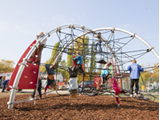 In a similar fashion, kids are motivated to use their whole bodies in open-ended climbing designs. Freestyle climbing is a relevant way for today's kids to improve their fitness. They climb the structure because it looks interesting, they do not immediately know what to do, they see other kids doing silly moves, it feels good, they want to reach the top, and they can challenge themselves to find unique ways of climbing or imitate their friends. Freedom of expression in this structure's non-prescribed routes appeals to their wish to be in control and to experiment according to their ability level. When acrobats and action heroes navigate this structure, they expose their bodies to: stretching, jumping, landing, using strength, observing, climbing up, down or sideways, swaying, balancing, turning, hanging by arms or knees, pulling up using arms, bending, transferring weight - and only the imagination sets limits. Underlying all these movement skills is a great workout of their vestibular, kinesthetic and proprioceptive senses as well. The social experiences in such a structure involve building relationships, negotiating rules of games, problem solving challenges and the art of making compromises.
In a similar fashion, kids are motivated to use their whole bodies in open-ended climbing designs. Freestyle climbing is a relevant way for today's kids to improve their fitness. They climb the structure because it looks interesting, they do not immediately know what to do, they see other kids doing silly moves, it feels good, they want to reach the top, and they can challenge themselves to find unique ways of climbing or imitate their friends. Freedom of expression in this structure's non-prescribed routes appeals to their wish to be in control and to experiment according to their ability level. When acrobats and action heroes navigate this structure, they expose their bodies to: stretching, jumping, landing, using strength, observing, climbing up, down or sideways, swaying, balancing, turning, hanging by arms or knees, pulling up using arms, bending, transferring weight - and only the imagination sets limits. Underlying all these movement skills is a great workout of their vestibular, kinesthetic and proprioceptive senses as well. The social experiences in such a structure involve building relationships, negotiating rules of games, problem solving challenges and the art of making compromises.
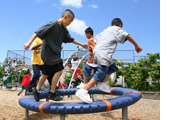 Smaller group structures such as the Supernova also bring kids together in physically active play. In this picture they are experimenting with speed, balance and a competitive game about who can stay on the longest. Other kids choose to play on the Supernova at a slower pace.
Smaller group structures such as the Supernova also bring kids together in physically active play. In this picture they are experimenting with speed, balance and a competitive game about who can stay on the longest. Other kids choose to play on the Supernova at a slower pace.
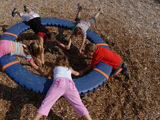 Here the collaborative imagination is coming together, providing the abdominal muscles with a great workout. Do not forget this exercise is done voluntarily because it is fun. It is not instructed by an adult. Free unstructured play results in a variety of experiences for kids, and on play equipment an important component is physical activity.
Here the collaborative imagination is coming together, providing the abdominal muscles with a great workout. Do not forget this exercise is done voluntarily because it is fun. It is not instructed by an adult. Free unstructured play results in a variety of experiences for kids, and on play equipment an important component is physical activity.
Play equipment features for physical activity
When we design environments for children to be active, it is important to remember that kids will go to great lengths to be physically active when it is fun. Designing to create such fun experiences requires making sure that the designs are visually attractive, allow for open-ended experimentation and use of imagination, offer graduated challenges, and have lots of built in features that afford social interaction. Stages to show off all their imaginative, physical and social abilities are desirable to kids. Playgrounds are highly motivating spaces for physical activity in unstructured play. The road to more physical activity in the lives of children must involve active play.
1.Parks, Playgrounds and Active Living, February 2010. www.activelivingresearch.org
2..www.facebook.com/play report
3..www.kompan.com
About the Author
 Helle Burlingame is an educator, author and Scandinavian educated psychologist (Cand. Psych) with a focus on human development, child development and environmental psychology.
Helle Burlingame is an educator, author and Scandinavian educated psychologist (Cand. Psych) with a focus on human development, child development and environmental psychology.
Areas of expertise: Children's Right to Play, Play and Changing Environments, Play and Health, and Play and Technology. She has more than 15 years of experience in managing education, outreach and research efforts. She is the Director of the KOMPAN Play Institute in North America and has presented numerous highly interactive workshops and keynotes for international, national and state professional groups. She offers a continuing education program for landscape architects, on child development and implications for design. She has been a speaker at the Harvard University Graduate School of Design's Executive Education Program on Childcare Design and is a board member of IPA (The American Association for the Child's Right to Play). Lastly, she is the editor of the KOMPAN Institute newsletter for North America. You can find a link to the e-newsletter on the KOMPAN website.
![]()
The next time you need a Landscape Architect on your project, consider O'Dell Engineering's Landscape Architecture Department.
Services include:
- Park and Playground Design
- Recreational Facility Design
- Site Planning
- Streetscape Design
- Urban Design
- Commercial Design
- 3-D Visualizations
- Graphic Design
- Arborist Consulting
Author: Helle Burlingame - Editor: Chad Kennedy, Landscape Architect
This informational article provided by O'Dell Engineering - 1165 Scenic Drive, Suite A, Modesto CA 95350
